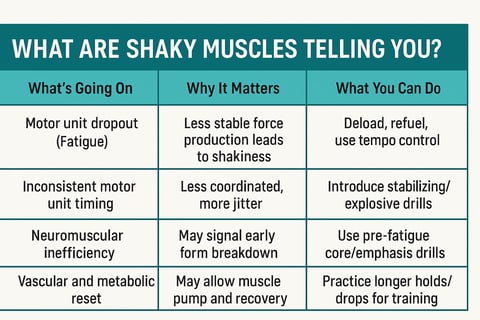What Shaky Muscles Really Mean: Fatigue, Instability, or a Deeper Issue?
Muscle shaking during workouts isn’t just fatigue—it’s your nervous system signaling overload. Discover the real causes, expert insights, and how to train smarter to prevent injury and improve performance.
6/8/20254 min read


What ‘Shaky Muscles’ Really Mean: Fatigue, Stability, or Something Else?
Kevin hit failure on his last set of squats and felt his quads trembling. Have you been there? These “shaky muscles” can feel alarming—but they’re actually part of the body’s complex response to challenge. In this post, we’ll unpack what muscle tremors mean, the research behind them, and how you can train smarter by understanding what’s really going on beneath the surface.
1. A Crash Course on Muscle Fatigue
Muscle fatigue happens when a muscle's ability to generate force drops—not due to a lack of strength, but due to physiological or neural stress. It can be split into:
Peripheral fatigue: Local factors—like depletion of energy stores, accumulation of metabolites, or impaired contraction mechanisms—limit a muscle’s ability to fire
Central fatigue: Originating in the brain or spinal cord, this type involves reduced neural drive to the muscle .
At the gym, both forms are in play. As reps pile up, local energy reserves drop while your nervous system starts throttling back nerve signals to protect the body.
2. Why Muscles Tremble: The Neuromuscular Breakdown
So where does the shaking come from? As fatigue sets in:
Some motor units drop out (they can’t sustain force), forcing the remaining ones to fire harder or more erratically
The body’s timing and coordination between motor units falter, causing alternating micro-contractions and relaxations that register as an involuntary tremor .
In simpler terms: the brain is still trying to produce the same force output, but the muscle fibers and neural signals have become less synchronized—resulting in visible shaking.
3. Shakiness vs. Pathology: What’s Normal?
There are two main tremor types:
Physiological tremor: Subtle, rhythmic oscillations everyone has during voluntary muscle activity
Pathological tremor: More pronounced, often rhythmic, may involve neurological disorders like essential tremor .
Post-hard-set shaking is almost always physiological, tied to fatigue and motor unit disruption—unless accompanied by other neurological signs like loss of coordination or resting tremor.
4. Physiological Tremor: A Temporary Safety Mechanism?
A fascinating 2022 case report had 22-year-old volunteer hold a plantar flexion, 30% MVC, holding until his muscles shook scirp.org. After tremor episodes, EMG readings and heart rate dropped slightly, while blood flow increased. The researchers speculated the tremor was a self-resetting mechanism—loosening pressure so blood flow improves and prolongs contraction ability.
This suggests tremors may be an adaptive, protective mechanism during prolonged static work—not just a byproduct of fatigue.
5. When Expert Voices Back It Up
Strength coach and sports scientist Nick Tumminello discussed muscle tremor as a sign of incomplete motor unit recruitment and rising instability in the neuromuscular chain. He told a fitness magazine crew:
“That shake? It’s a neural whisper—it’s your system fighting to hold form under load” (Paraphrased).
His point: rather than being a flaw, tremor alerts us that our coordination is nearing its limit under fatigue—and that compensations are starting to form.
6. So, What Are Shaky Muscles Telling You?
7. Addressing the Root: Training Smarter
If you’re constantly shaking under weight, your goal is to build resilience and coordination under load. That means:
Stability under load: Try controlled slow eccentrics or paused reps to force consistency.
Full-range tempo work: Practice eccentric‑pause‑explode patterns to refine neural timing.
Pre-activation drills: A core training resistance band used during kneeling anti‑rotation work can sharpen neural recruitment while tiring stabilizers—building a better foundation.
8. It’s More Than Fatigue—It’s Complexity
Heavy or high rep work challenges multiple systems at once:
Central nervous system limitations kick in
Blood flow and waste clearance mechanisms activate
Neural signal timing deteriorates
That’s why during a tough set, shakiness can rise, fall, then rise again—as internal systems reset dynamically, not linearly.
9. Losing or Keeping Form?
Shaking is a window into form breakdown. You might:
Sag in the torso
Let knees cave
Fail to brace on lifts
In those moments, grit won’t help—coordination will. Instead of pushing through, slow the rep, lower the load, or pause to regain neural control.
A quality lifting belt can sometimes give the torso feedback to brace—but remember: it’s a training tool, not a crutch.
10. Outside the Gym: Shaking Pops Up Elsewhere
Notice shakiness during everyday life? Holding a child after a long day, prolonged standing at a counter, or carrying groceries—those shaky muscles may show up too. It’s still the same story: fatigue + imperfect recruitment.Slowing down, taking micro-breaks, or swapping hands early aren’t laziness—they’re smart self-preservation.
11. When Should You Be Concerned?
For most people, post-set tremors are normal. But check with a professional if:
Shaking comes with weakness or loss of coordination
The tremor occurs at rest or constantly
Tremors are intense, rhythmic lands (4–12 Hz range) beyond exertion context
Medical conditions: Such as neuropathy, essential tremor, Parkinson’s, etc.
Otherwise, these tremors are likely temporary muscle fatigue signals.
12. Smart Adjustments You Can Make
Deload cycles: Allow neural recovery
Mixed tempo training: Integrate explosive lifting after controlled eccentrics
Hydration & nutrition: Fuel nerves and muscles—fatigue shows up faster on empty reserves
Core-bracing tools: A well-timed core belt/trainer helps with intra-abdominal pressure—not as gear dependency, but biofeedback for bracing
Final Thoughts: Embrace the Shake (and Then Improve It)
“Shaky muscles” aren’t just fatigue—they reveal a system reaching its coordination limits and recovering dynamically. Understanding this opens the door to smarter training: less wasted effort, better durability, and stronger neuromuscular control. Next time you feel that tremor creeping in—don’t panic. Listen, adjust, and train purposefully. Your system is talking. It's up to you to fine-tune the message.


FITNESS
Nutrition
WellnesS
info@movebetterco.com
© 2025. All rights reserved | Privacy Policy | Terms & Conditions